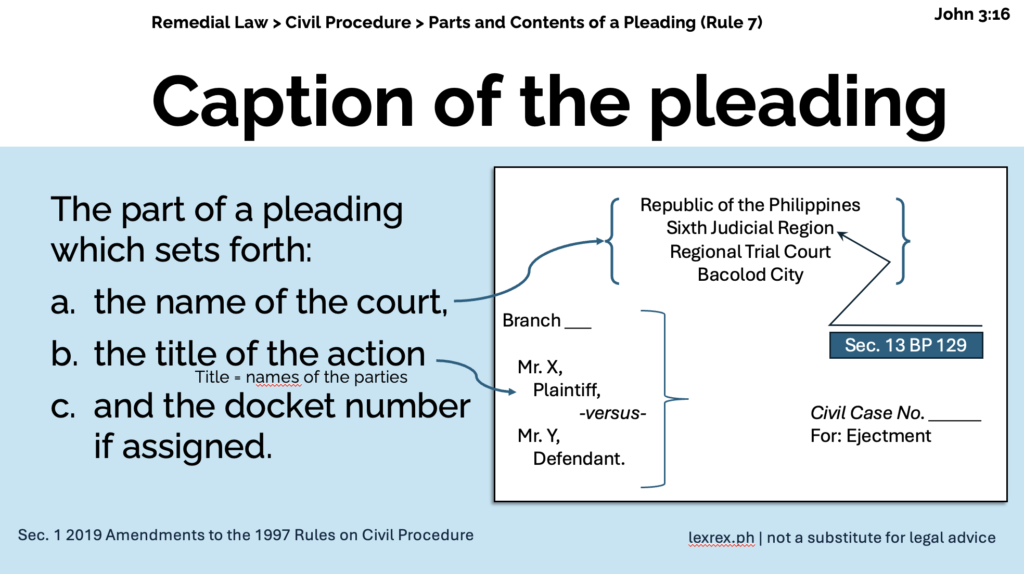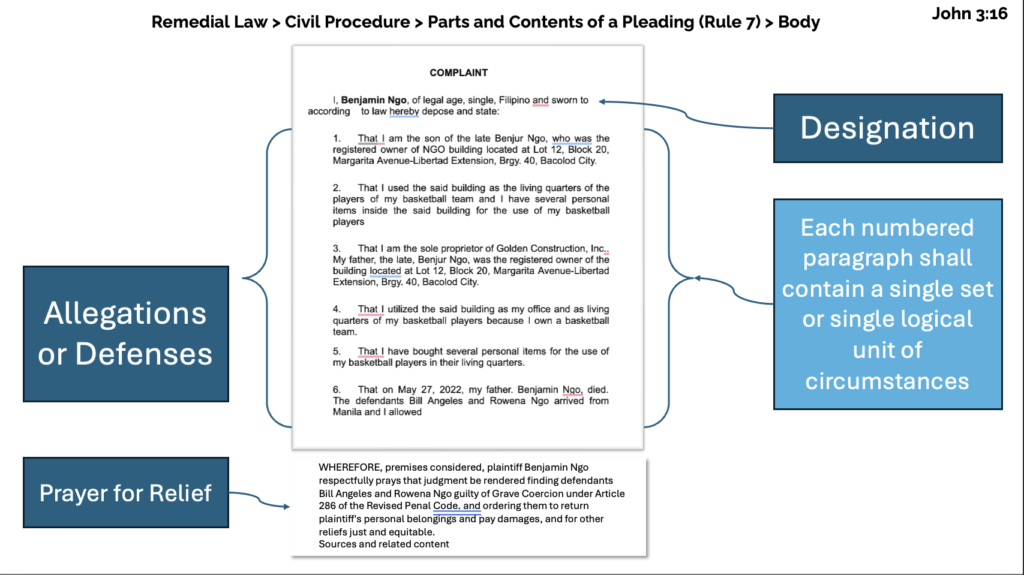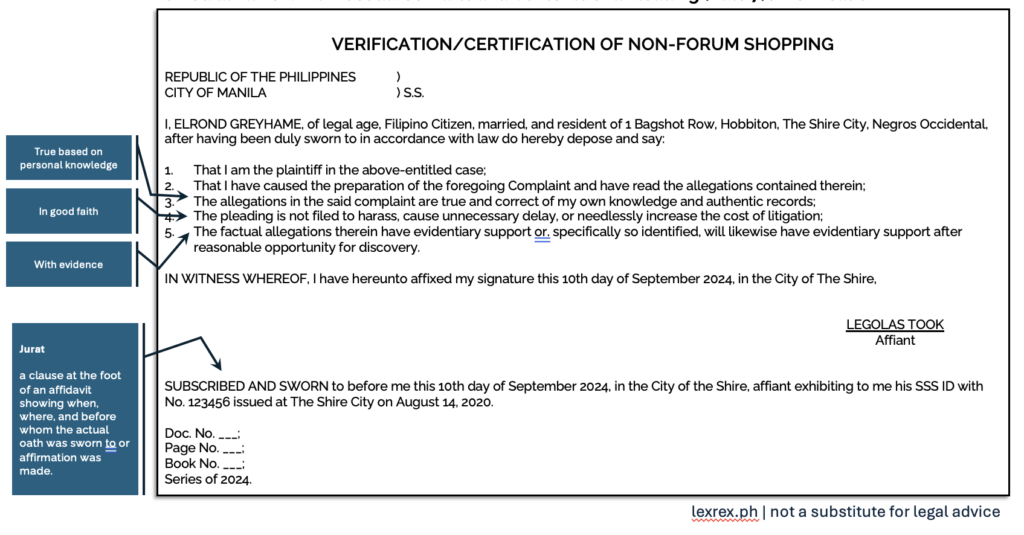Based on the sources you provided, a pleading generally has several key parts and required contents. Rule 7 of the Rules of Court, as referenced in several sources, outlines these aspects.
General Parts of a Pleading:
According to Rule 7, a pleading typically consists of the following parts:
Caption:

This sets forth the name of the court, the title of the action (names of the parties and their respective participation), and the docket number if one has been assigned. The respective participation of parties in the case should be indicated in the title. For electronically-filed or served pleadings, and submissions served by facsimile, the title should contain sufficient information to allow the court to ascertain the filing/serving party, the nature of the paper, the party/parties against whom relief is sought, and the nature of the relief sought.
Body:
The body of the pleading contains several essential elements:

- Designation: This clearly states what the pleading is (e.g., Complaint, Answer).
- Allegations: This section sets forth the party’s claims or defenses in a methodical and logical form. It must contain a plain, concise, and direct statement of the ultimate facts, including the evidence on which the party relies to support their claim or defense. Ultimate facts are essential facts without which the statement of the cause of action or defense would be insufficient. While ultimate facts are required, the pleading does not need to include details of probative matter or particulars of evidence which establish the material elements. If the cause of action or defense is based on law, the pertinent provisions of the law and its applicability should be clearly and concisely stated. Fraud and mistake must be averred with particularity.
- Every pleading asserting a claim or defense must also state the names of witnesses who will be presented to prove the claim or defense.
- It must include a summary of the witnesses’ intended testimonies, provided that the judicial affidavits of these witnesses are attached to the pleading and form an integral part of it. Generally, only witnesses whose judicial affidavits are attached may be presented during trial, except with meritorious reasons for admitting additional witnesses. In Summary Procedure cases, judicial affidavits shall be attached to the complaint/answer and form an integral part thereof.
- The pleading must also include documentary and object evidence in support of the allegations.
- Relief Prayed For: This section specifies the judgment or order that the party seeks from the court. Generally, a court cannot grant relief not prayed for, or in excess of what is sought. However, a general prayer for other just and equitable relief may be included. In all complaints, petitions, answers, and similar pleadings, the amount of damages prayed for should be specified in both the body and the prayer, as this will be considered in assessing filing fees. Failure to comply with this may result in the pleading not being accepted, admitted, or being expunged from the record.
- Date: Every pleading must be dated.
End Part:

- Signature and Address: Every complaint and other written submission to the court must be signed by the party or the counsel representing them, indicating their address. The signature of counsel serves as a certificate that they have read the pleading and documents, that to the best of their knowledge, information, and belief, formed after a reasonable inquiry, the pleading is not filed to harass, cause unnecessary delay, or needlessly increase the cost of litigation, and that the factual allegations have evidentiary support or will have after a reasonable opportunity for discovery. The signature of the affiant also serves as a certification of the truthfulness of the allegations.

- Verification: All pleadings in cases under the Rules on Expedited Procedure in the First Level Courts must be verified. Verification is done through an affidavit under oath attesting that the allegations in the pleading are true and correct based on personal knowledge or authentic documents, and that the pleading is not filed to harass, cause unnecessary delay, or needlessly increase the cost of litigation.
Specific Contents Based on Type of Pleading/Action:
- Complaint: A complaint is a pleading alleging the plaintiff’s cause or causes of action, stating the names and residences of the plaintiff and defendant. It initiates a civil action. The allegations in the complaint, not just the prayer, determine the basis of the plaintiff’s relief.
- Answer: An answer is a pleading where a defending party sets forth their defenses, which can be negative or affirmative. A negative defense is a specific denial of material facts essential to the claimant’s cause of action. An affirmative defense is an allegation of new matter that, while hypothetically admitting the claimant’s allegations, would prevent or bar recovery.
- Pleading an Actionable Document: When an action or defense is based on a written instrument or document (an actionable document), the substance of the document should be set forth in the pleading, and the original or a copy must be attached as an exhibit, forming part of the pleading. Alternatively, the document may be quoted verbatim in the pleading. The genuineness and due execution of an actionable document are deemed admitted unless specifically denied under oath by the adverse party, setting forth the claimed facts, except when the adverse party is not a party to the instrument or when inspection of the original is refused.
- Motions: While not pleadings themselves, written motions must state the relief sought and the grounds for it, and be accompanied by supporting affidavits and other papers if required by the Rules or necessary to prove the facts alleged. The rules applicable to pleadings regarding caption, designation, signature, and form also apply to written motions.
- Petition for Review: A petition for review of judgments and final orders must state facts with certainty, clearly present the issues, set forth the grounds and brief arguments, and pray for judgment annulling or modifying the questioned decision. It must also comply with the Material Date Rule by stating specific material dates showing timely filing and contain a sworn certification against forum shopping.
- Special Civil Actions: Initiatory pleadings in special civil actions generally contain the claiming party’s causes of action (except interpleader and declaratory relief), the names and residences of the parties, a plain, concise, and direct statement of ultimate facts, and evidentiary facts or evidence relied upon. They also require the names of witnesses, summaries of their testimonies with attached judicial affidavits, and documentary/object evidence. A certification against forum shopping with proof of authorization is also needed.
- Summary Procedure: In civil cases under Summary Procedure, the complaint must state the names of affiants whose judicial affidavits will prove the claim, a summary of these affidavits, and the documentary and object evidence. The judicial affidavits must be attached.
It is important to note that all pleadings should comply with Rule 7, and if prior barangay conciliation is required, the pleading must include a statement of such compliance; otherwise, the complaint may be dismissed without prejudice until compliance.